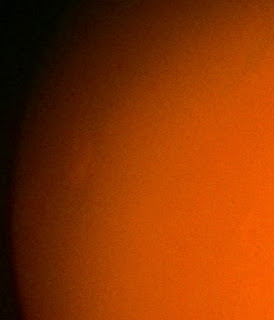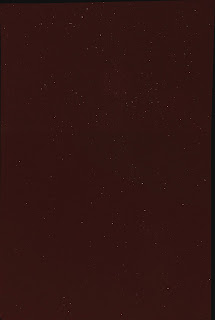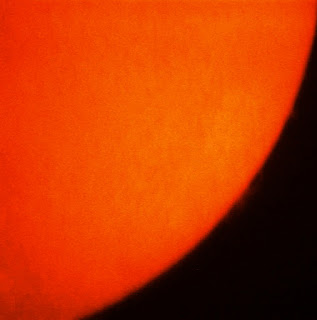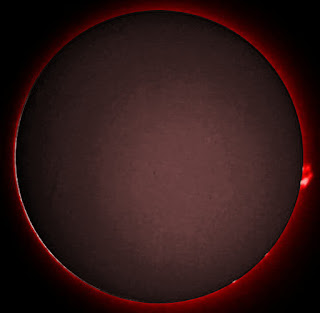Summary
You can watch the monthly summary here, accompanied by "Free Bird" by Lynrd Skynrd:
Weather ruined the month, with very little dark observing possible, apart from the Moon. Many of my solar hydrogen alpha reprocesses revealed data that I did not bring out at the time. I completed my round of hydrogen alpha reprocesses and had started reprocessing old Mercury shots.
I managed some hydrogen alpha shots during the days and also a few "white light" shots of the Sun. I didn't manage many Moon shots but was pleased with the ones I did.
October 31st 2300 GMT
By moonrise, it had cleared a bit. The haze was scattering the moonlight, making deep sky viewing near impossible. I stacked 114 frames to get this image.
October 31st 1950 GMT
After a clear afternoon, I was anticipating a clear evening to do some constellation and deep sky photography. Unfortunately, it was rather cloudy. Even the normally reliable Melotte 20 was barely visible to my binoculars and the Pleaides (M45) only showed about 10 stars. The Andromeda Galaxy (M31) was hardly visible at all.
There was no point in taking the camera out!
October 31st 1325 GMT
A second attempt to bin scan the sun revealed new activity.
October 31st 1310 GMT
The sky had cleared somewhat and I checked the Sun in hydrogen alpha light. I could see the sunspots that I had missed but the disc otherwise appeared rather bland. I took some full disc shots and close-ups.
October 31st 1150 GMT
I bin scanned the Sun under hazy conditions and did not see the sunspots visible on the Big Bear images.
October 28th 1215 GMT
I attempted a white light solar shoot, having seen some sunspot activity in the Learmonth images. However, I did not see any sunspots in the viewfinder and none was obvious in the first scan of the images. However, some small ones were visible after image processing.
October 28th 1200 GMT
Conditions were a bit hazy but I decided to go ahead with a hydrogen alpha shoot anyway. Although the Sun appeared rather quiet, there was a stand-out feature of a prominence and nearby plage.
October 26th 1220 GMT
Conditions were hazy but I managed to capture a sunspot on “film” in white light. I used ISO 200 at 1/4000 second with my Skymax 127.
October 26th 0840 GMT
I was up quite early but had to wait for some cloud to clear. Even then, conditions were far from perfect. As the day before, the Sun looked rather quiet in hydrogen alpha light. A quck check of the images showed that I had captured some surface detail.
October 25th 2100 GMT
The early evening was hazy but it cleared later to show the Moon in a clear sky. There was some cloud near the horizon but it was well to the south. The Hyades and Pleaides were visible but I felt that it would be better to wait until the Moon was absent.
The Moon was approaching full and I reduced the exposure time to 1/2000 second. I stacked 61 images, using my normal methods.
October 25th 1150 GMT
I tried to photograph the Sun in white light with my Mak and DSLR. There was lots of haze about and I tried several settings. I managed to capture a faint sunspot and pick up some granulation.
October 25th 1040 GMT
It wasn't completely clear but I checked the Sun with my PST. The disc was quite bland, with a couple of prominences. I took full disc and close-up views. Unfortunately, little detail was in the photos.
October 24th 1810 GMT
It was still clear but the temperature was dropping rapidly and I had a cold. I took 81 frames of the Moon at ISO 400 and 1/1600 second exposure. I used GIMP to finish off, removing almost all of the red and blue channels.
October 24th 1600 GMT
After a drenching morning, it cleared to the west. I managed to see the Sun outside the supermarket. I’m glad I checked it because it was below a bank of cloud by the time I got home. I saw a single sunspot.
October 22nd 2050 GMT
Finally, some clear sky in the evening. The Moon was waxing gibbous and there was haze spreading its light. I took several full disc lunar frames at ISO 400 and 1/1000 second exposure with my Skymax 127. I had to do a lot of camera fiddling before I could obtain an image.
I bin scanned the Pleiades (M45), despite the poor conditions because I just love looking at them. It was clear that I would not get a good photo but I saw the main 25 to 30 stars. The Hyades showed well, although the background haze was horrible, with them being lower down. The Andromeda Galaxy (M31) showed a surprisingly amount of detail, given the conditions.
October 21st
The clear sky was short-lived. I had finished processing the solar hydrogen alpha photos for the time being, so started on Mercury. I could only detect the phase in this photo from March 22nd 2004.
I added a reprocess from June 23rd 2005.
October 20th 1055 GMT
Finally, some clear sky! I bin scanned the Sun but only saw a single sunspot.
October 18th Evening
It is even more annoying when it is cloudy at weekends, so it was down to another reprocess, this time from June 10th 2014.
October 17th Evening
Cloud again. I adjusted the yellow channel only of this solar hydrogen alpha photo from July 6th 2014.
October 15th Evening
With rain and 100% cloud, I reprocessed a solar hydrogen alpha photo from April 26th 2014.
October 15th 1440 GMT
After a patchy day, it finally cleared and I was able to see a sunspot, at last.
October 14th Evening
I reprocessed a solar hydrogen alpha photo from September 3rd 2013.
October 14th 0645 GMT
I wasn't totally sure whether the Sun had risen or not but I saw Venus. A bin scan suggested a 30% phase.
October 13th 1135 GMT
I bin scanned the Sun but didn’t see any sunspots. Given the quiet images on Big Bear, this was not a total surprise.
October 12th 2045 GMT
I took a few overhead frames but left the ISO setting on 400. I caught Cygnus and parts of Cepheus from 3 stacked frames.
October 12th 1105 GMT
I bin scanned the Sun. I had a bit of trouble finding focus and, after careful searching, did not find any sunspots. I had seen some on the Big Bear images but they were too small to see in my binoculars.
October 12th 0740 GMT
I checked the Sun with my PST. The disc was quite featureless but I saw a prominence at about the one o’clock position. I took some full disc and close-up shots.
October 12th
I woke up early and hungry, so did some work on my book.
October 11th
I reprocessed a solar hydrogen alpha shot from August 31st 2013.
... and another two from May 4th 2013.
Here's another one from May 6th 2013.
October 10th
I reprocessed a solar hydrogen alpha shot from April 3rd 2013.
October 10th 1320 GMT
I bin scanned the Sun through thin cloud but did not see any sunspots.
October 7th
Some viewing may have been possible but I was down with the lurgy and wanted to get better for the Orionid meteors. I reprocessed a solar hydrogen alpha photo from March 24th 2012.
October 6th Morning
I woke up to light rain and 100% cloud cover. I reprocessed a solar hydrogen alpha shot from March 20th 2012.
October 6th 1420 GMT
I finally caught some clear sky but a bin scan did not reveal any sunspots.
October 5th
I reprocessed a solar hydrogen alpha shot from March 11th 2012.
... and two from March 19th 2012.
... and March 20th 2012.
October 4th
I reprocessed a solar hydrogen alpha shot from July 27th 2012.
October 4th 2315 GMT
I had a look while letting our dogs out. Some stars were visible but there was enough haze to dissuade me from trying to photograph anything. However, I saw a meteor of magnitude -1 flash south to the east of Cygnus.
October 3rd 1310 GMT
I bin scanned the Sun but did not see any sunspots. I also checked later in the afternoon.
October 2nd 2140 GMT
I was hoping to have a better session than the evening before but there was lots of haze around. There seemed little point in trying deep sky or constellation photography. The Moon was just up but rather faint, so I took 63 frames at ISO 400 and 1/400 second exposures.
October 2nd 1100 GMT
I was working from home, so went out with the Mak and DSLR. Conditions were slightly hazy, so I took some frames at 1/2000 second, instead of the usual 1/4000. I saw an aeroplane cross the solar disc but was not quite ready!
October 1st 2100 GMT
I went out with my DSLR and set it up with ISO 6400 and 300mm focal length. I tried 1/4000 second on the Moon but the main aim was to get focus. I tried Melotte 20, a starfield in Scutum (hoping for M11) Albireo, Alcor/Mizar and Nu Draconi. I used 2 seconds exposure.
Early indications suggested some camera shake.
October 1st 1245 GMT
The clouds cleared later, so I managed to bin scan the Sun. One sunspot group appeared close to rotating off, while another was almost central.
October 1st 0845 GMT
I bin scanned the Sun through moving cloud but did not see any sunspots.


































































